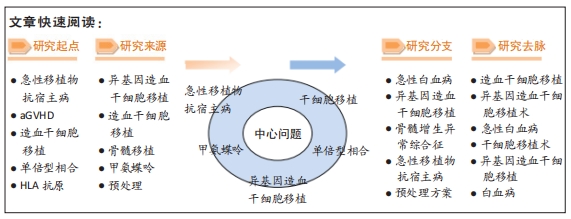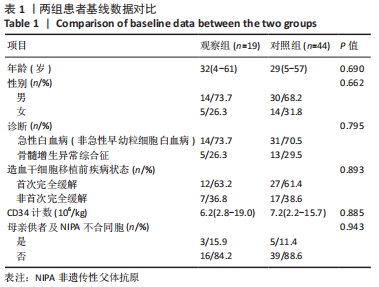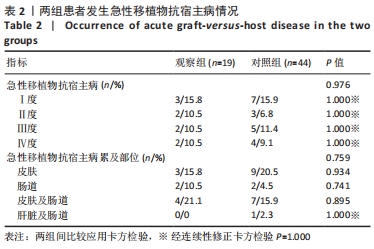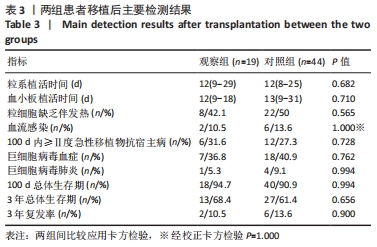[1] ALCAZER V, PEFFAULT DE LATOUR R, ADER F, et al. Graft failure after allogeneic hematopoietic stem cell transplantation: Definition and risk factors. Bull Cancer. 2019;106(6):574-583.
[2] YU S, HUANG F, WANG Y, et al. Haploidentical transplantation might have superior graft-versus-leukemia effect than HLA-matched sibling transplantation for high-risk acute myeloid leukemia in first complete remission: a prospective multicentre cohort study. Leukemia. 2020; 34(5):1433-1443.
[3] YUCEBAY F, MATTHEWS C, PUTO M, et al. Tocilizumab as first-line therapy for steroid-refractory acute graft-versus-host-disease: analysis of a single-center experience. Leuk Lymphoma. 2019;60(9):2223-2229.
[4] SALEHNASAB C, HAJIFATHALI A, ASADI F, et al. Machine Learning Classification Algorithms to Predict aGvHD following Allo-HSCT: A Systematic Review. Methods Inf Med. 2019;58(6):205-212.
[5] WANG Y, LIU DH, LIU KY, et al. Long-term follow-up of haploidentical hematopoietic stem cell transplantation without in vitro T cell depletion for the treatment of leukemia: nine years of experience at a single center. Cancer. 2013;119(5):978-985.
[6] CHANG YJ, XU LP, WANG Y, et al. Controlled, Randomized, Open-Label Trial of Risk-Stratified Corticosteroid Prevention of Acute Graft-Versus-Host Disease After Haploidentical Transplantation. J Clin Oncol. 2016;34(16):1855-1863.
[7] WANG Y, WU DP, LIU QF, et al. Low-dose post-transplant cyclophosphamide and anti-thymocyte globulin as an effective strategy for GVHD prevention in haploidentical patients. J Hematol Oncol. 2019; 12(1):88.
[8] LIN R, WANG Y, HUANG F, et al. Two dose levels of rabbit antithymocyte globulin as graft-versus-host disease prophylaxis in haploidentical stem cell transplantation: a multicenter randomized study. BMC Med. 2019;17(1):156.
[9] BROWN P, INABA H, ANNESLEY C, et al. Pediatric Acute Lymphoblastic Leukemia, Version 2.2020, NCCN Clinical Practice Guidelines in Oncology. J Natl Compr Canc Netw. 2020;18(1):81-112.
[10] BEZINELLI LM, EDUARDO FP, NEVES VD, et al. Quality of life related to oral mucositis of patients undergoing haematopoietic stem cell transplantation and receiving specialised oral care with low-level laser therapy: a prospective observational study. Eur J Cancer Care (Engl). 2016;25(4):668-674.
[11] PENACK O, MARCHETTI M, RUUTU T, et al. Prophylaxis and management of graft versus host disease after stem-cell transplantation for haematological malignancies: updated consensus recommendations of the European Society for Blood and Marrow Transplantation. Lancet Haematol. 2020;7(2):e157-e167.
[12] 陈育红,黄晓军,许兰平,等.异基因造血干细胞移植中甲氨蝶呤3次与4次给药的比较[J].北京大学学报(医学版),2003,35(2): 215-216.
[13] 张之南,沈悌.血液病诊断及疗效标准[M].4版.北京:科学出版社, 2021.
[14] 中华医学会血液学分会干细胞应用学组.中国异基因造血干细胞移植治疗血液系统疾病专家共识(Ⅰ)——适应证、预处理方案及供者选择(2014年版)[J].中华血液学杂志,2014,35(8):775-780.
[15] SCHOEMANS HM, LEE SJ, FERRARA JL, et al. EBMT-NIH-CIBMTR Task Force position statement on standardized terminology & guidance for graft-versus-host disease assessment. Bone Marrow Transplant. 2018;53(11):1401-1415.
[16] FORMAN SJ, NEGRIN RS, JOSEPH H, et al. Thomas’ Hematopoietic Cell Transplantation: Stem Cell Transplantation[M]. 5th Ed. John Wiley & Sons, Ltd. 2015: 1012-1019.
[17] BAUTISTA F, MORENO L, FERNÁNDEZ-NAVARRO JM, et al. Evaluation of chimerism by quantitative PCR analysis of DNA polymorphism after allogeneic hematopoietic stem cell transplantation in a pediatric population with malignancies. Pediatr Transplant. 2011;15(1):81-87.
[18] DOSS LM, DANDOY CE, KRAMER K, et al. Oral health and hematopoietic stem cell transplantation: A longitudinal evaluation of the first 28 days. Pediatr Blood Cancer. 2018;65(1):e26773.
[19] 周茜,陆铉,唐亮,等.恶性血液病单倍型造血干细胞移植预处理中兔抗人胸腺细胞球蛋白剂量优化探讨[J].中华血液学杂志, 2020,41(7):557-563.
[20] WANG Y, CHANG YJ, XU LP, et al. Who is the best donor for a related HLA haplotype-mismatched transplant? Blood. 2014;124(6):843-850.
[21] ANASETTI C, BEATTY PG, STORB R, et al. Effect of HLA incompatibility on graft-versus-host disease, relapse, and survival after marrow transplantation for patients with leukemia or lymphoma. Hum Immunol. 1990;29(2):79-91.
[22] HAN LJ, WANG Y, FAN ZP, et al. Haploidentical transplantation compared with matched sibling and unrelated donor transplantation for adults with standard-risk acute lymphoblastic leukaemia in first complete remission. Br J Haematol. 2017;179(1):120-130.
[23] YU W, WANG Y, WU D, et al. Comparison of efficacy between HLA6/6- and HLA3/6-matched haploidentical hematopoietic stem cell transplant in T-cell-replete transplants between parents and children. Sci China Life Sci. 2019;62(1):104-111.
[24] 中华医学会血液学分会干细胞应用学组.中国异基因造血干细胞移植治疗血液系统疾病专家共识(Ⅲ)--急性移植物抗宿主病(2020年版)[J].中华血液学杂志,2020,41(7):529-536.
[25] GUPTA A, PUNATAR S, MATHEW L, et al. Cyclosporine Plus Methotrexate or Cyclosporine Plus Mycophenolate Mofetil as Graft Versus Host Disease Prophylaxis in Acute Leukemia Transplant: Comparison of Toxicity, Engraftment Kinetics and Transplant Outcome. Indian J Hematol Blood Transfus. 2016;32(3):248-256.
[26] NUNES LFM, DE ARRUDA JAA, SOUZA AF, et al. Prophylactic photobiomodulation therapy using 660 nm diode laser for oral mucositis in paediatric patients under chemotherapy: 5-year experience from a Brazilian referral service. Lasers Med Sci. 2020;35(8):1857-1866.
[27] 刘慧霞,邵珊,姜杰玲,等.去除第11天甲氨蝶呤方案预防同胞相合供体造血干细胞移植后急性移植物抗宿主病[J].内科理论与实践,2018,13(2):87-91.
|





